Samsung Galaxy S 5 Review
by Anand Lal Shimpi & Joshua Ho on April 8, 2014 12:00 AM EST- Posted in
- Smartphones
- Samsung
- Mobile
- Galaxy S 5
CPU Performance
The Galaxy S 5 marks the second Snapdragon 801 based device we've reviewed at AnandTech, the first being HTC's M8. I've gone through the Snapdragon 801 in depth already, but we're basically dealing with a reasonable upgrade to Snapdragon 800 on an improved 28nm HPm process. The bulk of the improvements impact GPU and ISP performance, but the SoC is just better overall. GS5 owners are lucky as all versions of the device that use Qualcomm silicon feature the MSM8974AC v3 SKU, which includes four 2.5GHz Krait 400 cores and a 578MHz Adreno 330 GPU.
| Snapdragon 800/801 Breakdown | ||||||||||
| SoC Version | Model | Max CPU Frequency | Max GPU Frequency | ISP | eMMC | DSDA | Memory IF | |||
| MSM8974VV | v2 | S800 | 2.2GHz | 450MHz | 320MHz | 4.5 | N | 800MHz | ||
| MSM8974AA | v2 | S800 | 2.3GHz | 450MHz | 320MHz | 4.5 | N | 800MHz | ||
| MSM8974AB | v2 | S800 | 2.3GHz | 550MHz | 320MHz | 4.5 | N | 933MHz | ||
| MSM8974AA | v3 | S801 | 2.3GHz | 450MHz | 320MHz | 5.0 | Y | 800MHz | ||
| MSM8974AB | v3 | S801 | 2.3GHz | 578MHz | 465MHz | 5.0 | Y | 933MHz | ||
| MSM8974AC | v3 | S801 | 2.5GHz | 578MHz | 465MHz | 5.0 | Y | 933MHz | ||
Although Samsung was the first major OEM to be caught cheating in Android benchmarks, it appears to have completely abandoned the practice with the Galaxy S 5's shipping software. Not only was I unable to find any evidence of the old cheats, I couldn't find any evidence of HTC's new subtle cheating either. The Galaxy S 5 appears to be clean as far as I can tell. Kudos to Samsung on doing the right thing, and I hope all other OEMs take this as a sign to stop the silliness.
For our performance tests I turned to our usual suite of browser and native applications. If there's one obvious takeaway from our CPU tests it's that despite having faster silicon than HTC's M8, the GS5 isn't always faster. I believe this has more to do with thermals than anything else. HTC's metal chassis is able to do a better job of dissipating heat than the GS5's plastic chassis. I don't believe there's a substantial impact on user experience, but it's interesting to note how choice in materials can have a performance impact like this.
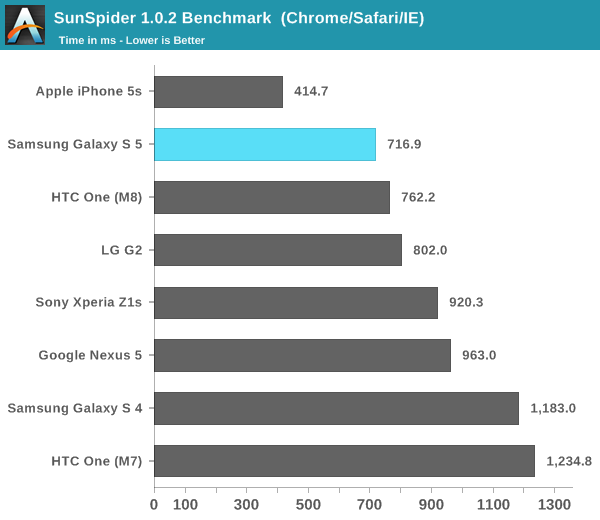
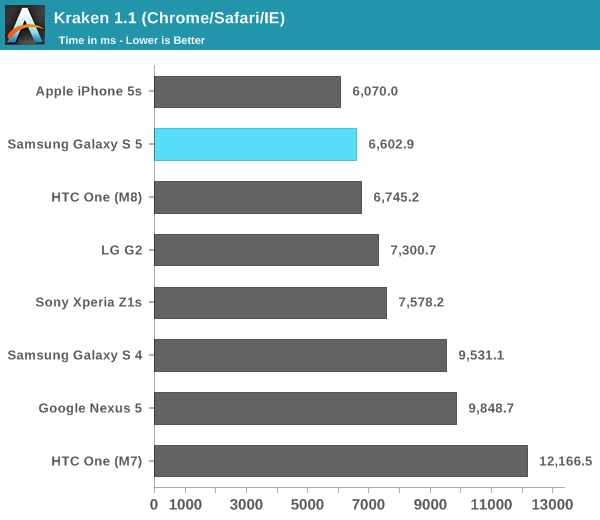
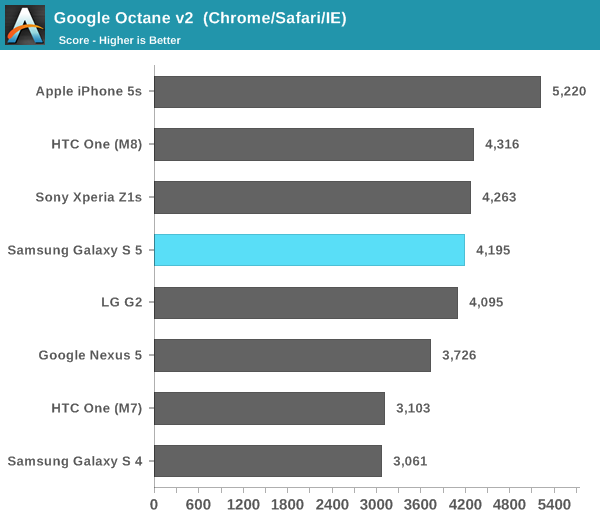
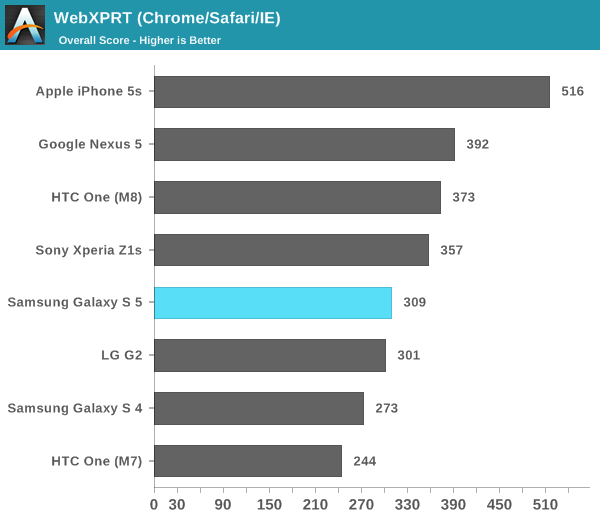
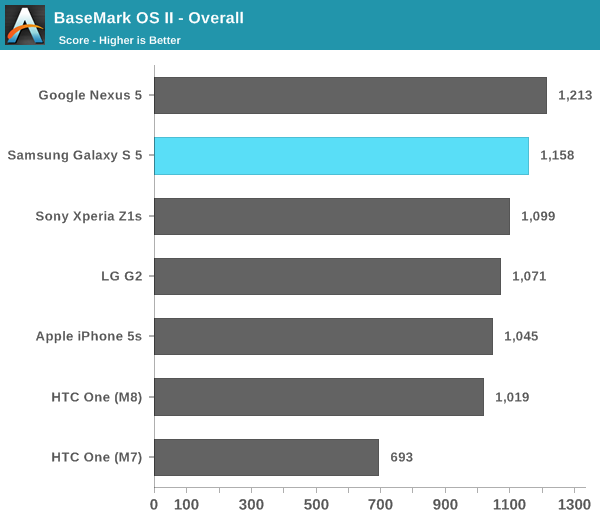
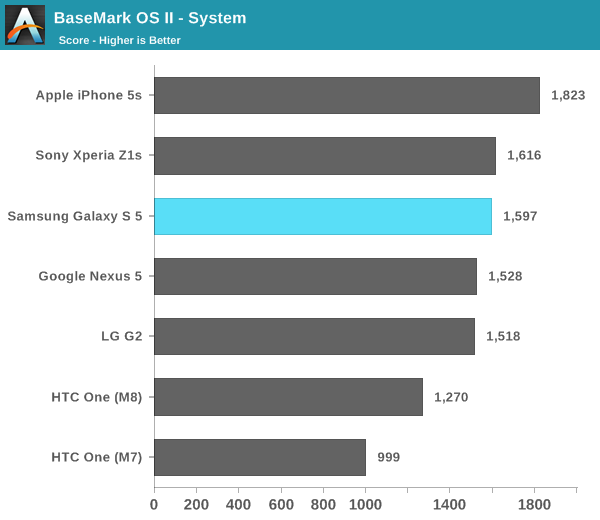
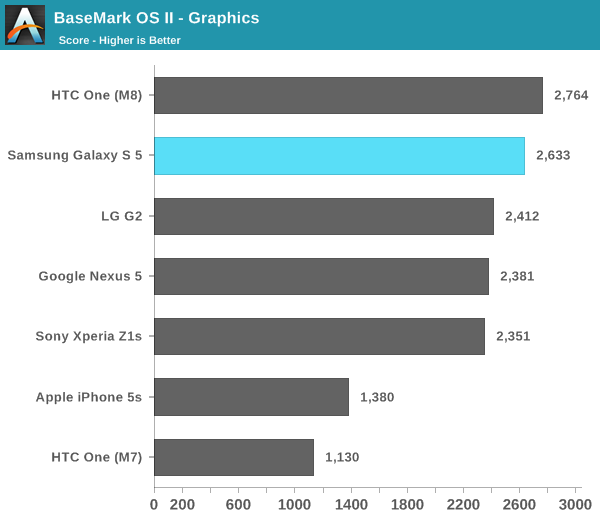

GPU Performance
GPU performance remains where we see the biggest benefit from Snapdragon 801 vs. 800, and since the GPU gains are almost entirely due to frequency scaling it's not too surprising that the M8 pulls ahead of the GS5 here in most cases.
There aren't any surprises here. The Adreno 330 in the Galaxy S 5 is more than capable of driving the device's 1080p display both in current and near term future 3D games.
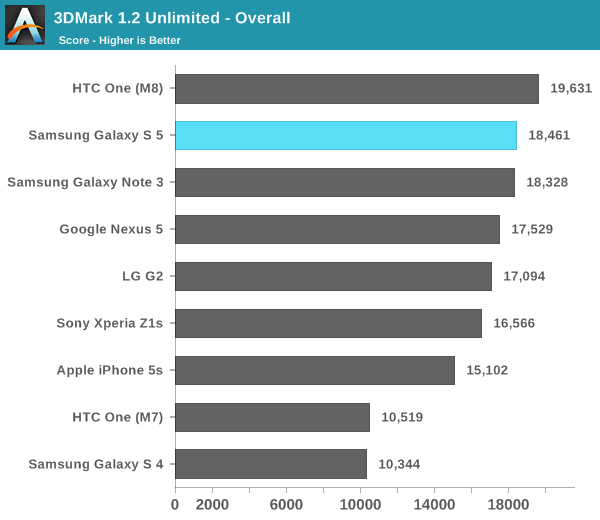
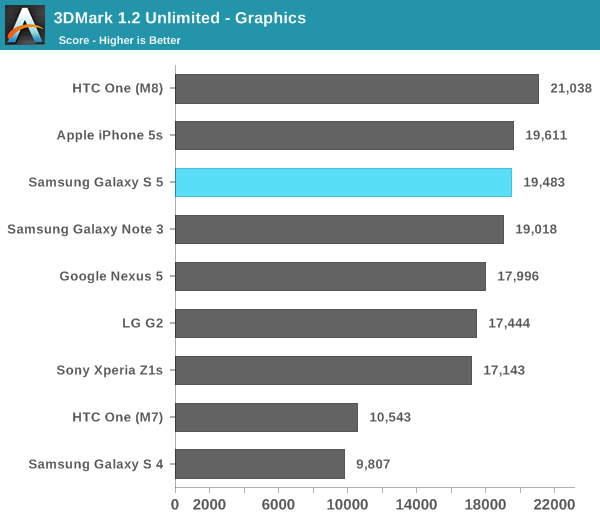
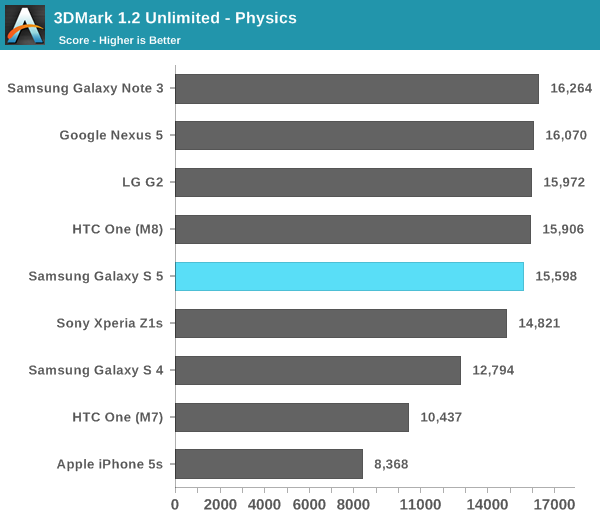
BaseMark X 1.1
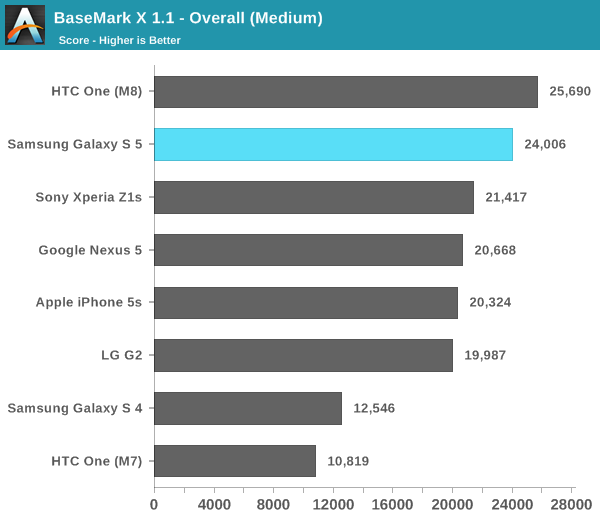

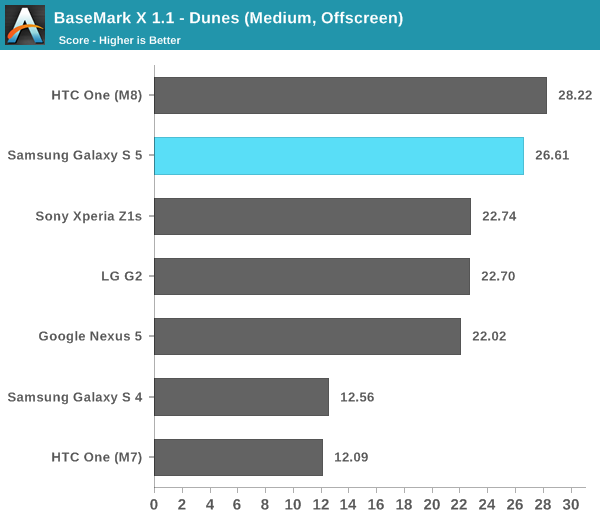
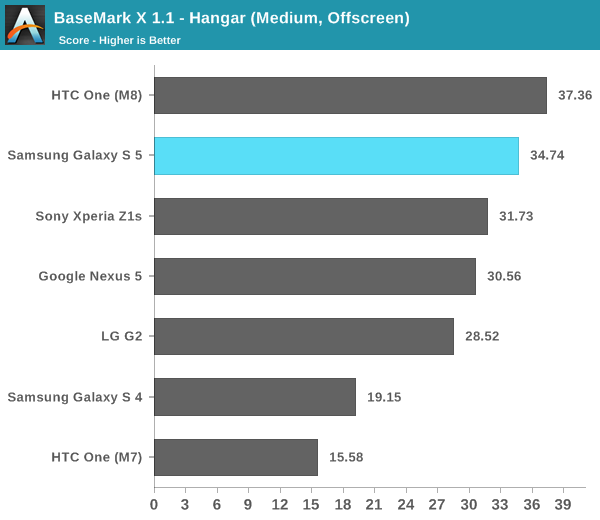

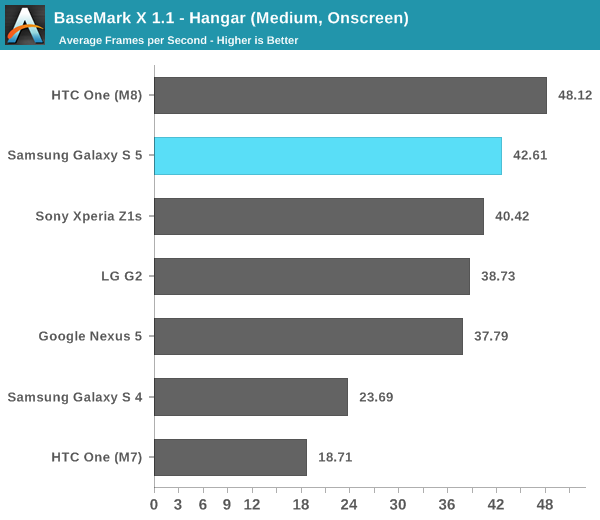
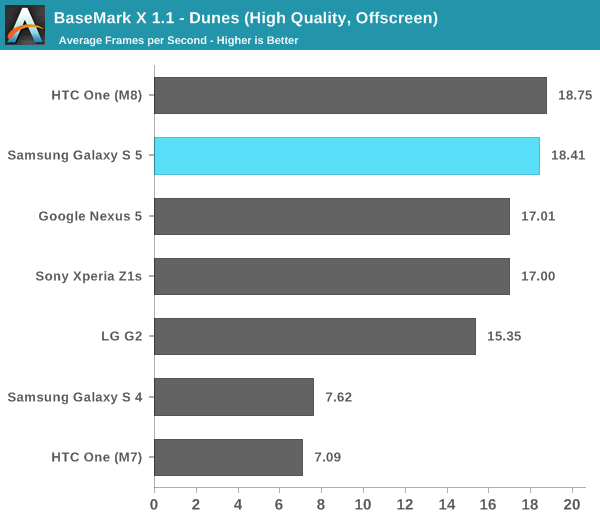
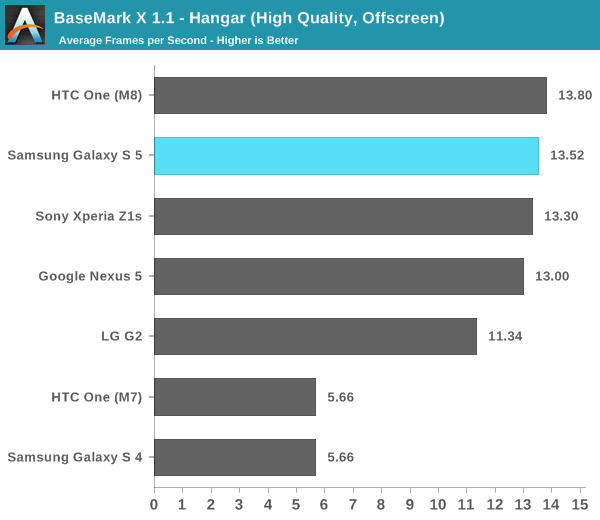
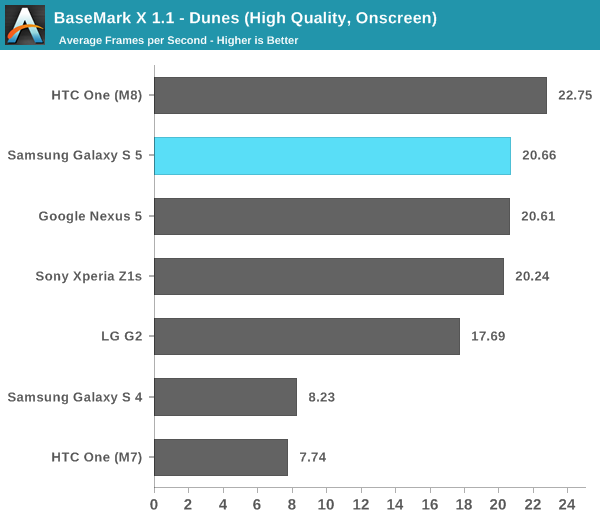
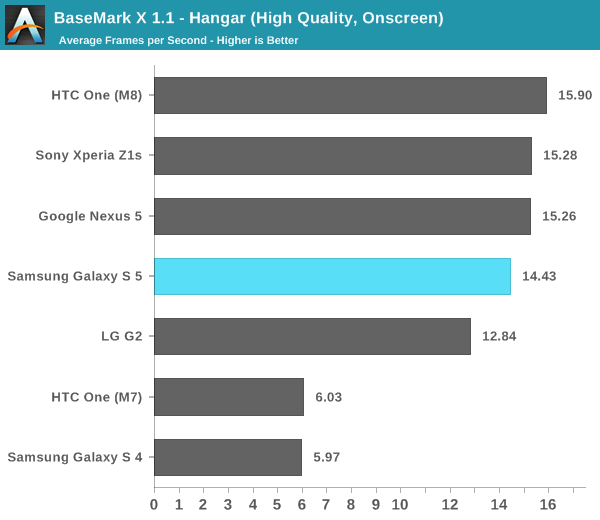
GFXBench 3.0
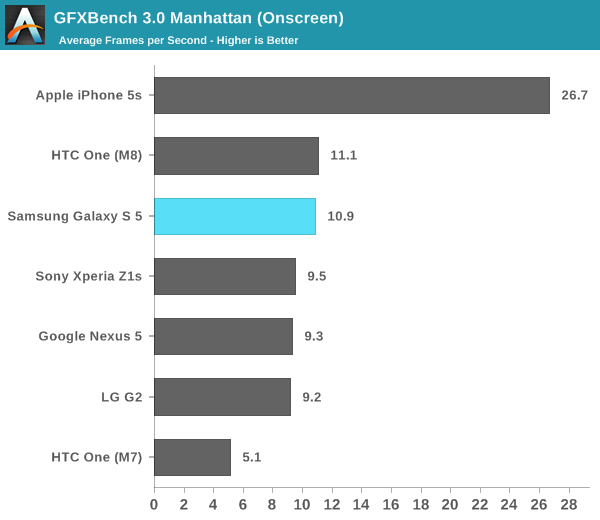
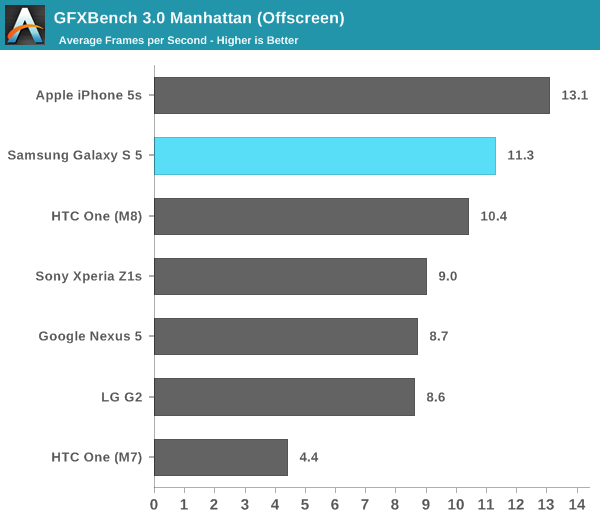
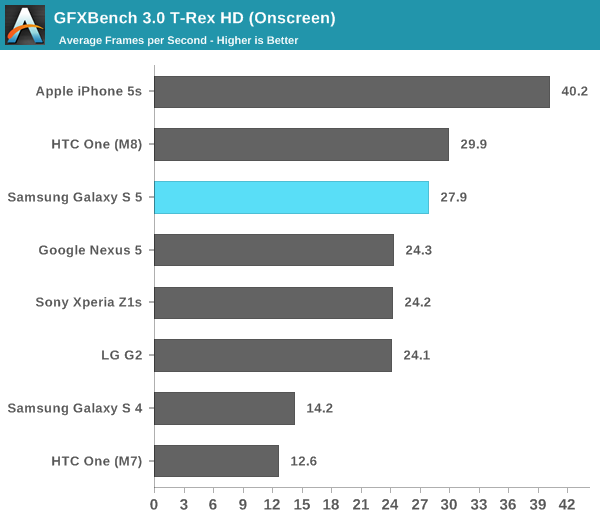
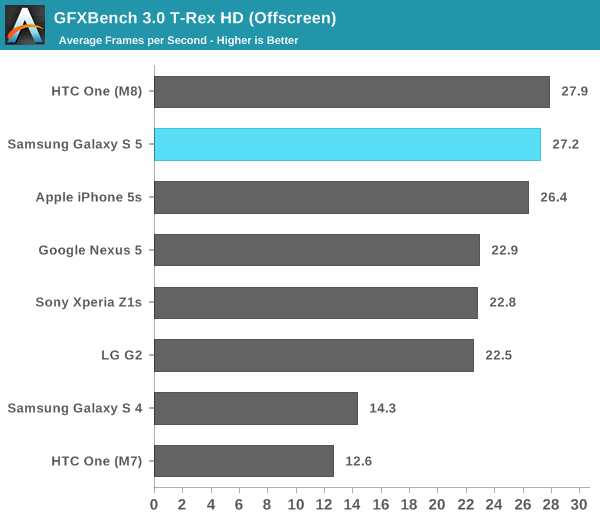

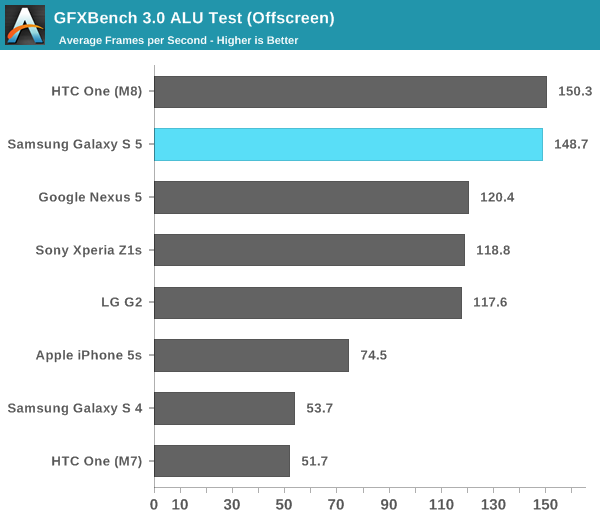


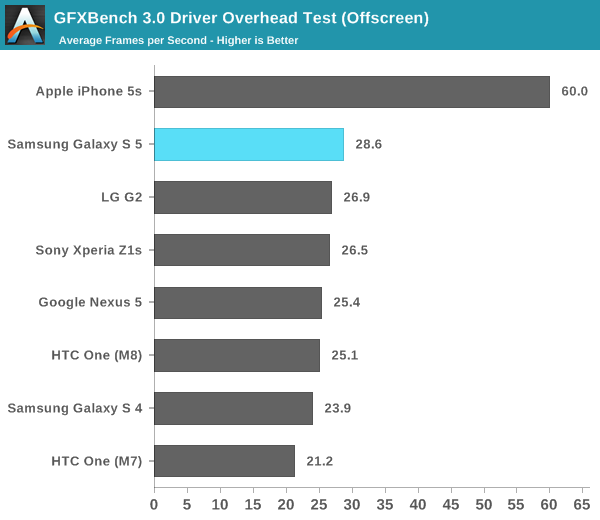
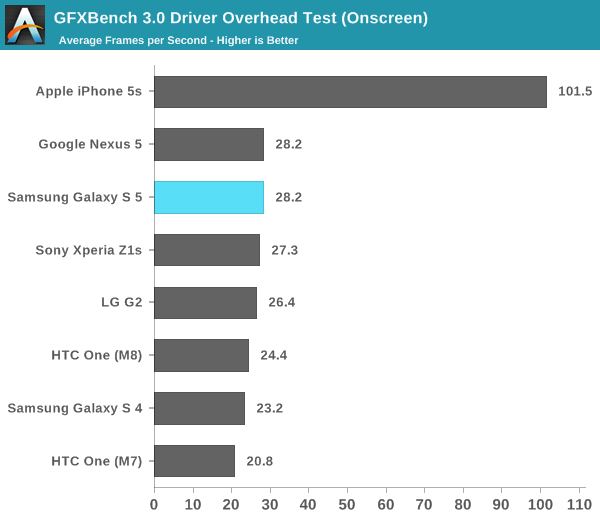
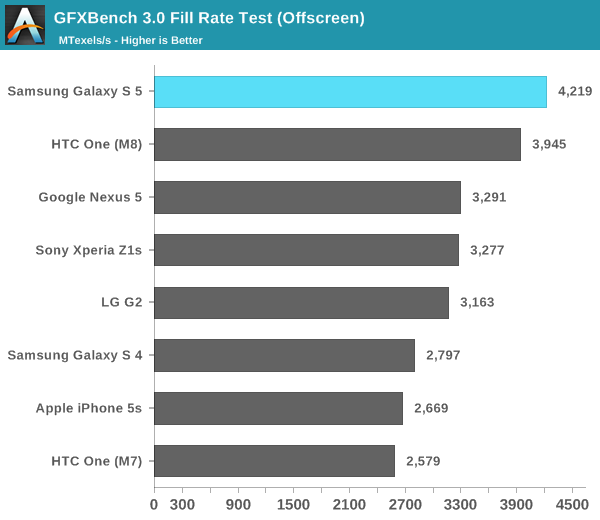
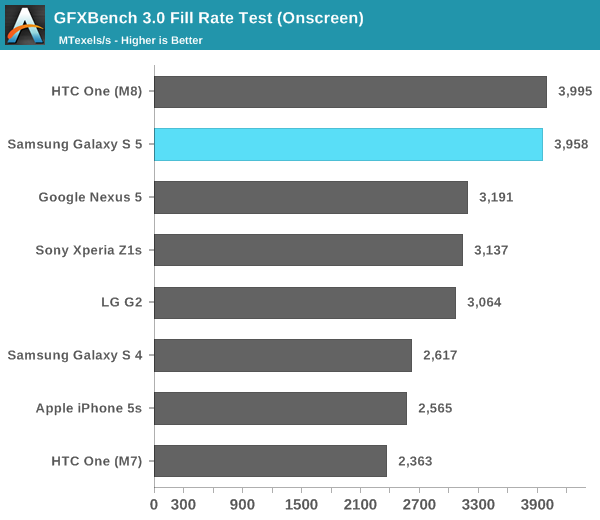
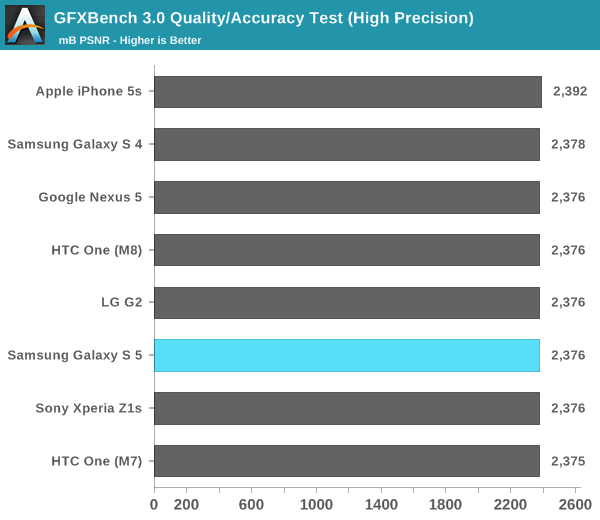
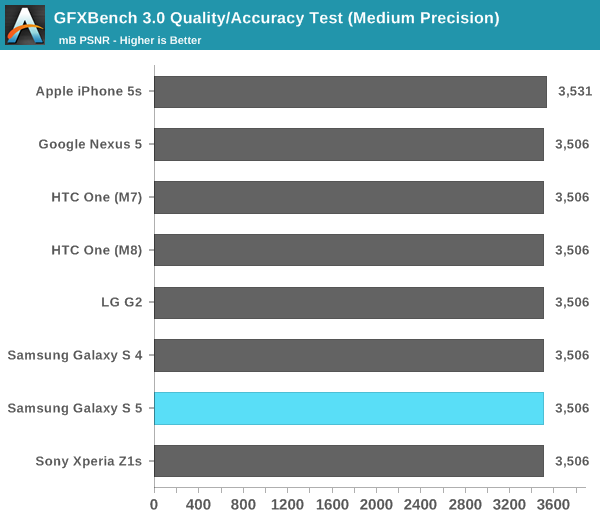
NAND Performance
The GS5 ships with 16GB or 32GB of NAND internally on an integrated eMMC device. Expansion is supported through a microSD card slot behind the removable back cover. Although the Snapdragon 801 inside supports eMMC 5.0, that alone doesn't guarantee a substantial increase in NAND performance. Keep in mind that most OEMs find multiple sources for their internal eMMC/NAND solutions, so what I'm testing here may only be representative of a portion of all GS5 devices.
Samsung sampled a 16GB GS5 review device. I put it through our usual random/sequential IO tests on a 100MB span of LBAs.
Random read performance is disappointing, it falls behind all modern devices we've tested. Random write performance is middle-of-the-road at best. It's unclear to me if this is a cost optimization or a lack of concern for NAND performance, but either way I'd rather see these metrics improve rather than regress.
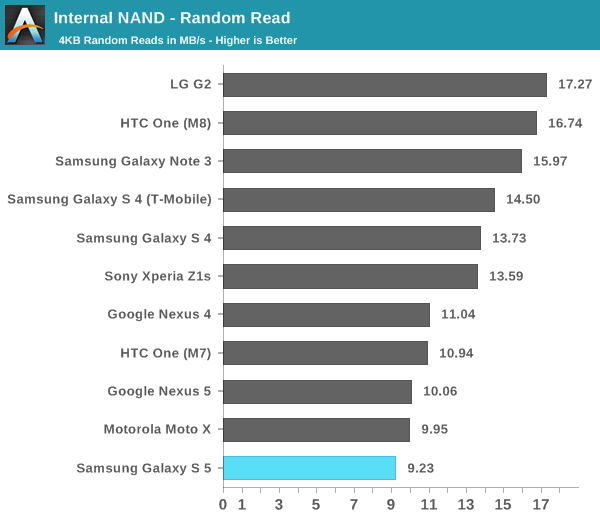
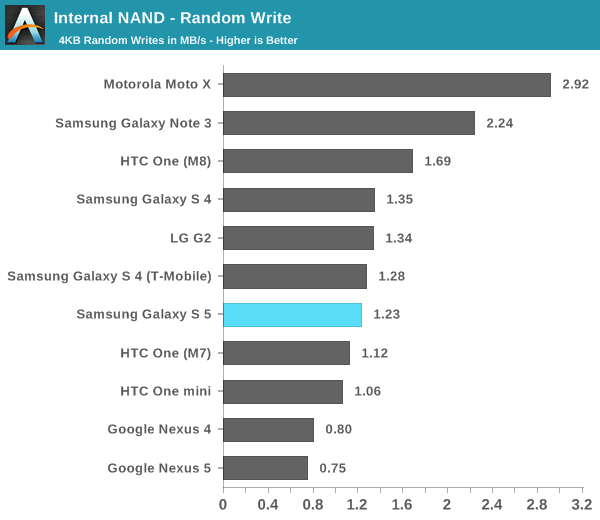
Sequential read/write performance both improve handsomely compared to the Galaxy S 4. I can see why Samsung would want to optimize for these two cases as they are quite common in regular usage, but random read/write performance can also significantly impact user experience.
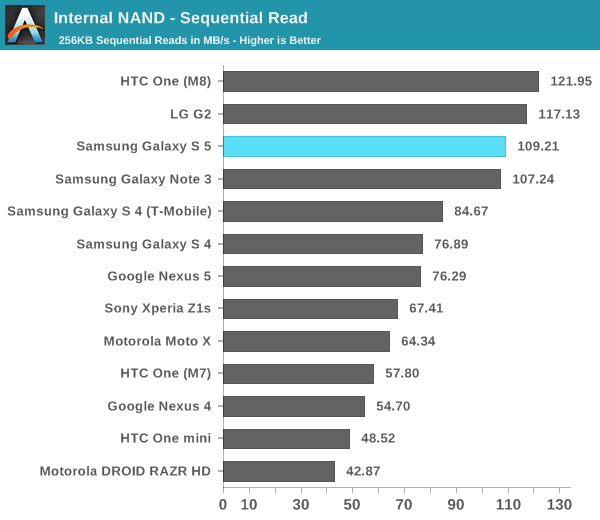
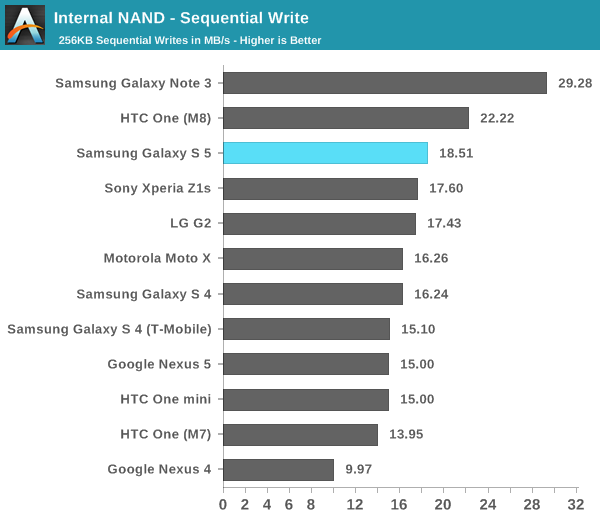










296 Comments
View All Comments
Brian Z - Wednesday, April 9, 2014 - link
Yes you are a obvious fanboy.I have not said nor has anybody else said that Samsung wad the only one.
Hell this site has a theme going up where they update the benchmark cheating chart. But yet you still push your BS.
And Samsung was the only OEM to actually overclock the gpu. But since it's Samsung you got the nerv to even suggest well is it really cheating....
They complained loud and clear about this. In public on the reviews. In public on the podcast. Even in public we want Sony to send us a phone so we can see if they are cheating and add them to the chart
And now they are advertising the m8 in the article. So I guess you weren't paying any attention ever when a review compared different SoCs bins. Like the Samsung Galaxy s4 with its 1.9ghz s600 in the nexus 7 2013 article. Funny how that isn't advertising. Or when comparing screens on the tablets in the market. But of course you're a blinded fanboy so yeah.
They "discovered" the cheating not because it was Samsung. Because somebody on twitter Tweeted at Brian Klug and they investigated it from there. They weren't even looking for it period. And what did they do right after testing it on the Samsung device. Look at all the other players in the market to see if they were doing it. But facts and reality don't matter a delusional fanboy like yourself.
Oh and keep telling yourself aluminum is cheap crap. Aka a beer can.
Clueless uninformed pathetic fanboy
doobydoo - Friday, April 11, 2014 - link
TheSailorMan - you can't go round spouting fanboy crap such as iAnand and expect to be able to claim you're not a fanboy. You're worse than anyone else I've seen.TheSailorMan - Sunday, April 13, 2014 - link
I REPEATI'm not fan boy to any brand!!!!!
And you hippocrates, do not lie, that this all BS was not meant OLNY for bashing Samsung .
Even here iAnand mention AGAIN Samsung slyly, but didn't mention it about HTC (they even did it again with M8 , and didn't give a sh.... about iAnand "discoveries", saying that it was NOT cheating )
Veruca5alt - Monday, April 28, 2014 - link
http://en.wikipedia.org/wiki/HippocratesVeruca5alt - Monday, April 28, 2014 - link
bahahahhaha what a trolltastic fanboy you arepuremind - Tuesday, April 8, 2014 - link
Good job on the display analysis this year guys. Last year theS4 review did not go into the dynamic brightness adjustment issue and I feel you have nailed this down this year.Though it would have also been nice to see the maximum brightnes in boost mode not only for 100% white but for an APL of 80% which is the average APL of web browsing content. It will probably be in the region of 500cd/m² based on the curves I measured last year.
http://forum.xda-developers.com/showthread.php?t=2...
If you look at the curves I produced and typical brightness for content at different APL levels, it shows how brightness progresses.
- On the S4 it decreased from 478cd/m² at 1% APL down to only 283cd/m² for a 100% white picture, so a 60% loss.
- On the S5, displaymate noted 698cd/m² at 1% APL and you noted 440cd/m² at 100% white, which is also about 60%.
-Based on the apparently same progression and prorating my results from last year, at 80% APL we should still have 475 cd/m2 for web browsing, which is very close to the HTC One (approx 500cd/m², through this also varies with APL). For video content and some web content we should actually see brightness well above 500cd/m².
You certainly did a much better job than Displaymate in terms of objectivity.
TheSailorMan - Monday, April 14, 2014 - link
"You certainly did a much better job than Displaymate in terms of objectivity."Really? Better job than Displaymate? LOL
iAnand did his job AGAIN.
Human Bass - Wednesday, April 9, 2014 - link
The really iffy thing I found about the S5 was the lack of OIS in the main camera.TheSailorMan - Monday, April 14, 2014 - link
Still one of the best on smatphones(if not the best)Blairh - Wednesday, April 9, 2014 - link
S5 reminds me a lot of the S4 Active which I used last year. Sucks to see HTC and Samsung go bigger and heavier this year.I have the Nexus 5 and I'll never pay more than $350 off contract for a phone ever again. 30 grams less than the N5. Speaker is fine for short YouTube vids. I use bluetooth speakers and headphones in all other situations. Camera is solid after 4.1.1. Lack of SD slot is a letdown but I pinned my favorite music. Feels amazing in hand. Stock Android. Can't recommend it enough. $300 less than S5 and M8 off contract. And AT&T saves me $15 a month for bringing my phone to their service.